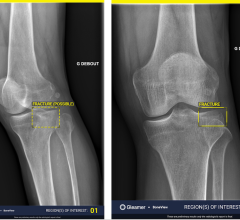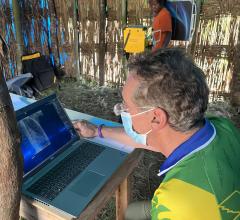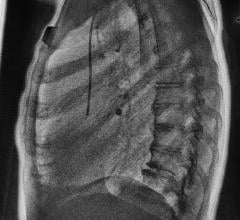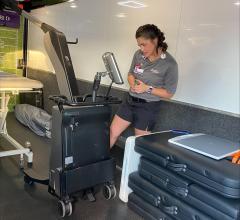
Fred Fischer, ALLPRO Imaging
Talk to the purveyors and supporters of digital radiography (DR) and you’ll hear that it’s the wave of the future and ultimately where the technology is headed – arguably replacing its earlier generation sibling, computed radiography (CR). However, raise that prospect with the CR crowd and you’ll likely hear something dramatically different. They’ll tell you that DR may be great but CR is here to stay, at least for the long haul. Why? Because digitizing film tends to be less costly upfront, involves fewer compatibility and configuration challenges with existing equipment, requires less education and training (particularly in the area of end-user behavior modification and overall mindset) so it’s less disruptive to the facility, and just may be sufficient for that facility’s needs and goals. Even as “next-generation” DR gains in popularity among acute care and outpatient care facilities alike, traditional CR retains and maintains a solid fan base, particularly in the outpatient arena where DR may not be as fiscally and operationally justified. Clearly, the manufacturers of both CR and DR foresee bright futures for their respective technologies, even when placed in the context of the emerging digital wave of technological development that encompasses convergence, flexibility, multifunctionality, additional power and speed. With both technologies seemingly ensconced in the healthcare industry it only makes sense to explore ongoing and future developments in CR and DR applications and capabilities, including how those developments impact overall performance. Because both plan to be in play for some time, it’s important to see where they’re heading and how they plan to get there. That’s why Outpatient Care Technology Editor Rick Dana Barlow ventured out to examine what the next-generation CR and DR applications will look like and how their function and role in clinical, financial and operational performance will be enhanced through technological development. Barlow asked key executives of leading CR and DR manufacturers to briefly share their insights on the technological progression of their products for outpatient care facilities. With increased interest in and migration to digital radiography but continued reliance on and solid support for computed radiography, what do you foresee as the next big development in both CR and DR applications, specifically as they relate to outpatient settings? Why? How do you envision these next-generation CR and DR applications functioning? Why do these new versions represent an advancement over current versions? What additional capabilities and features will be available to enhance patient care, particularly in the outpatient setting? If you could design and program the most futuristic CR and/or DR application what features would you include? Do you foresee any of these features being valuable to end-users? Finally, how realistic is it to expect cost-conscious outpatient care facilities to use it? Fred Fischer, vice president, ALLPRO Imaging, Hicksville, NY, www.allproimaging.com The future for CR is now. The Phosphor Storage Plate (PSP) was invented in 1947. CR is what engineers call a ‘mature technology’ so that there are unlikely to be any real surprises in the future. Novel ways of reading the latent image from the plate could be developed but they are unlikely to change the basic use of the device for low volume users. What could revolutionize this market is if a commercial/consumer electronics application was found for the plates used in DR. That would drop the price of DR plates and could spell the end of CR in most medical applications. Outpatient care is the next big market for digital imaging, and the chances are very good that it will be primarily a CR market due mostly to cost considerations. The big players have either purchased and rebranded lower-cost CR systems or have developed new lower-cost designs of their own. Small companies have developed their own innovative, lower-cost CR systems. Low-volume users, such as emergency care centers, medical offices, chiropractors, etc. would all like to operate without the cost and inconvenience of film, processing, darkroom, storage, etc., but there is a practical amount that they can spend to go digital. The costs associated with taking between eight and 16 films per day are $9,000 to $14,000 per year so that a single DR plate system costing over $100,000 is just not economically practical…and most users should have both a table and wall-mounted plate. DR systems using single CCD cameras compromise on image size, resolution and radiation dose. CR alone allows standard image size, good resolution and 400 speed at a cost that can be reasonably amortized. Just expose on the CR plate instead of film. It has been suggested that digitizing an already processed film will allow electronic transmission and storage. While this is true it does not make economic sense since, rather than reducing costs, it just adds on another layer to the cost of film, chemistry and processing. Admittedly, CR is like having a dry processor (without the need for supplies) so that it is not as ergonomic as DR ‘point and shoot.’ In a radiology center where patient throughput is important and there are sufficient patients, DR can make economic sense. But if the point is to eliminate film, chemistry and processors, and to have a digital image that can be enhanced for maximum diagnostic quality and stored and transmitted electronically, CR will be here to stay in the small user market for many years to come. Penny Maier, national marketing manager, digital X-ray, FUJIFILM Medical Systems USA, Stamford, CT, www.fujimed.com In many ways, digital X-ray parallels the PC industry – today’s users are better educated about the technology, have more sophisticated demands and expect products to perform faster, at a higher quality and an affordable cost. These demands dictate a significant industry transformation. And digital X-ray has experienced such an evolution. Over the past two decades, Fuji alone has introduced 25 new digital X-ray products that have each revolutionized the industry with improved image quality, speed, productivity and footprint, all a testament to our core competencies in engineering and utilization of customer feedback. Pushing the capabilities of technology is critical to addressing market needs, and Fuji is committed to being the vendor doing it best. Cuts in reimbursement have driven players in the healthcare industry to become increasingly efficient. Technology developments in digital X-ray should help facilities of all sizes respond to these pressures. Both CR and DR systems are positioned to do this. Both technologies can eliminate film and increase patient throughput. Through user feedback, Fuji learned that increased productivity is driven by system throughput as well as other factors which impact how quickly technologists can work. Fuji’s new Carbon products were designed to address these factors – high throughput, image access beginning in 10 seconds, only three steps to process an exam and easy selection of an unlimited set of anatomical menus to ensure optimal display of every image. And since the same technologist workstations are used with all of Fuji’s CR and DR systems, user familiarity and proficiency are maintained in all environments. While image quality will be an important focus of technological developments in the future, digital X-ray systems will also need to quickly adapt to advancements made in other industries. As processors become faster and networks are expanded, CR and DR systems will need to be designed in such a way to take advantage of these developments. Fuji’s digital X-ray systems are well-positioned for these changes. As they do today, CR and DR will continue to co-exist in coming years because each brings distinct and complementary advantages to users. CR offers flexibility for positioning and cost-effectiveness while DR offers higher throughput and the promise of better workflow. As we’ve seen over the past two decades, digital X-ray has undergone a dramatic transformation, and there’s no doubt that as we continue into the future, both CR and DR will evolve to offer even greater productivity gains, further improvements in image quality, and better outcomes for facilities of all sizes. Claus Grill, vice president, angiography & X-ray division, Siemens Medical Solutions, Malvern, PA, www.medical.siemens.com Imaging vendors, including Siemens Medical Solutions, will look toward increasing flexibility in their DR systems to meet or exceed the current flexibility of CR. Routine radiography still accounts for more than 70 percent of imaging. It is sustained at this point for its cost effectiveness, due to its commodity status. In addition, increased demand from niche markets such as orthopedics and emergency medicine/trauma have forced imaging vendors to develop DR systems that meet the patient comfort and positioning demands of these areas of medicine. CR has been embraced for its likeness in patient positioning to that of patient positioning via film/cassette-based systems. CR has, for the most part, been accepted by technologists because the basic workflow mimics that of conventional radiography. At Siemens, we have a great opportunity to design DR systems that meet or exceed technologist acceptance, while creating technology that offers excellent image quality. Siemens’ DR systems of the future will continue to be designed upon the distinct needs of the technologists, physicians and patients. As these needs change, whether it is hardware or software, certain components will be fine-tuned. Siemens is designing its DR portfolio of products to fulfill the needs of what has become a broader segment of customers. Orthopedics and trauma, as well as pediatric and oncology specialties, require customized solutions and options for specific workflow and patient needs. There will be increased flexibility in the detector positioning and organ programming, advanced image processing, improved patient and staff security standards and software targeted to the specialties mentioned above. All of these facets will consistently improve productivity for staff and increase patient satisfaction as well. In the next 10 years and beyond, CR will most likely be a technology of the past. Siemens will continue its goal of manufacturing DR systems that enhance productivity and patient throughput. Advanced applications, as they continue to be developed, will also aid in the diagnosis and treatment of diseases. In addition, Siemens will continue its goal of providing DR systems with patient comfort and radiation reduction features without sacrificing image quality. Connectivity will also play a large part in our system designs. Siemens already has DR systems with these features. Image quality, dose reduction and connectivity are and will continue to be what drives our design strategy. When completing a pro forma, outpatient facilities planning on increasing patient census and specialties while decreasing operating costs, such as human resources, supplies, space, etc. will see that in the long term, DR is the technology of choice. These centers may need a higher initial investment, but they should be able to efficiently accommodate more patients with fewer resources. This is surely a wonderful way to pull in new patients, retain current patients and grow the center. Satisfied patients, staff and physicians are the end goal. Ted Ciona, senior marketing manager, CR/DR Solutions, Agfa HealthCare, North America, Ridgefield Park, NJ, www.agfa.com/healthcare Both CR and DR will be needed to meet the diverse needs of healthcare facilities, including outpatient centers and hospitals, from single-room facilities looking for an economical CR solution to a multiroom facility that requires a high-volume solution. With increasing demand for higher image quality and performance, especially in pediatric and orthopedic applications, new technology like Agfa’s DirectriX needle-based image detector and DX-S Scanhead reader system, will offer capabilities and performance equal to or greater than many DR installations with a more attractive price ratio. Beyond the introduction of economical single plate/single room solutions, the most dramatic trend with CR is the introduction of high-performance models. In the future, high-performance CR units will be closely integrated with the X-ray unit control to allow for automatic exposure settings and for X-ray exposure data to be included with the DICOM image. Radiologists will benefit from access to the patient dose, kvp and mAs when viewing diagnostic images on a workstation. The ability to create smaller tabletop devices is based on improvements in optics, laser diodes components and more efficient light collection techniques. New techniques in detector design allow for dramatic increases in image quality and system performance (speed, image access, etc.) to the levels previously obtainable by dedicated DR systems. As a result of industry experience, as well as the constant advancements in computers and software, traditional CR continues to become more cost efficient over time. Systems supporting in- or near-exam room applications that also allow for advanced processing and image control will become the norm. Although advanced controls and image processing will not always be needed, when required they will be critical. For example, availability of raw image data for advanced reprocessing and image enhancements, specialty annotation and measurement tools for orthopedic and pediatric applications, security logging to facilitate HIPAA compliance and management functions. Experience has proven that a lightweight cassette-based solution offers the best efficiency and workflow in an X-ray room. Additionally, if we use the new high-speed and rapid image access needle IP and Scanhead designs, along with interoperability with the X-ray generator for exposure controls, systems will gain even more performance and cost advantages. In the future, systems will take greater advantage of [radiofrequency] tag and proximity detection technology to automate the patient identification process, use image processing software capabilities to identify the exam or view and to automatically process the image to an optimum level with no interaction from the technologist. John Ross, vice president, Marketing, Anexa Corp., Peabody, MA, www.anexanow.com CR, which has been around for nearly 30 years now, is a mature technology. DR positioning systems are the major issue with the outpatient location and are a vendor-to-vendor issue. Some are reasonably versatile and some have not yet even evolved from the classic table and wall bucky systems and need CR to function. This makes them financially untenable. DR panel technology has much to accomplish to penetrate the fixed low-to-medium volume outpatient application. Price must come down and functionality must increase (rapid sequence imaging, real-time imaging, etc.) CR is slower than film/screen and doubles the radiation to the patient compared to film or DR. Outpatient studies tend to represent the healthy family X-ray; the issue is obvious if seldom mentioned. We need an option if ALARA is to have any meaning at all. If price and versatility approach that of CR at low volume and there is no radiation dose or image-quality sacrifice as with current ‘low-end’ systems, they will be the default outpatient choice. The ability to rapidly scan an ER patient for AP and lateral whole body exam or to be able to do routine exams like a barium swallow can relieve the workload on old fluoro machines or add a needed trauma capability will add value and price justification. Tomosynthesis and other more esoteric applications are near as well. At a basic level, on some systems two detectors and CR are required just to be full service. Other systems can be a challenge just to position. New ‘Designed for DR’ approaches dramatically improve this issue. Film changer-like operation and positioning flexibility fix the basic issues with many of today’s systems. Most ‘single detector’ systems are optimized now. With the exception of low-end CCD systems, DR has a 2:1 radiation dose advantage. The only issue is patient volume because of price. Flat panel systems and CT are growing together in terms of basic receptor hardware. Various versions of these fully evolved systems will cover the basic radiograph to the full cardiac exam. The value will be the ability to target the machines feature set to the task at hand and pay for what you use. In the near term a properly priced, versatile system without a severe dose or function penalty, as it is now with low-end systems, will be the default. More futuristic flat panel systems referred to earlier will be extremely cost effective from an outcomes point of view.




 December 10, 2025
December 10, 2025 








